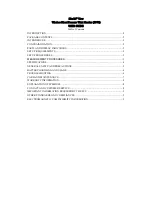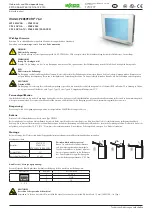
10
8.2 pH/ORP electrode cleaning
•
Salt deposits: Dissolve the deposits by immersing the electrode in tap water for
ten to fifteen minutes. Then thoroughly rinse with distilled water.
•
Oil/Grease film: Wash electrode pH/ORP bulb gently in some detergent and
water. Rinse electrode tip with distilled water or use a general-purpose electrode
cleaner (see ordering information).
•
Clogged reference junction: Heat a diluted KCl solution to 60 to 80 C. Place the
sensing part of the electrode into the heated solution for about 10 minutes. Allow
the electrode to cool in some unheated KCl solution.
8.3 Conductivity electrode
For general cleaning, the use of deionized water will be sufficient. Rinse the
electrode thoroughly in the deionized water. After cleaning, wipe the electrode dry.
Never touch the metal sensors.
For intensive cleaning, when the electrode is contaminated, wash it carefully with a
mild detergent, after which wash thoroughly with deionized water. Always ensure
that there are no blockages of the electrode cavity. If there is, use a gentle jet of
water to dislodge any particles that may have been stuck there.
9 TROUBLE-SHOOTING
GUIDE
Problem Cause
Solution
No display
a). Power adapter is not
connected properly or is
faulty.
a). Check that power adapter and
its wire are in place and
making good contact.
b). Check power supply.
Unstable
readings
a). Air bubbles in probe.
b). Dirty probe.
c). Probe not deep enough
in sample.
d). External noise pickup or
induction caused by
nearby electric motor.
a). Tap probe to remove bubbles.
b). Clean the probe and re-
calibrate.
c). Make sure sample entirely
covers the probe sensors.
d). Move or switch off interfering
motor.
No response
a). Broken probe.
a). Replace probe
Slow response
a). Dirty / Oily probe.
a). Clean probe. See “Electrode
Care & Maintenance” section.





































